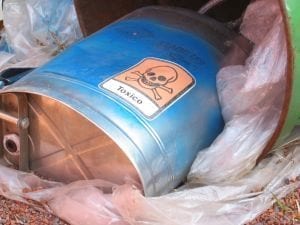The term toxic waste is widely used and difficult to define.
For easy reference it should include substances which are harmful to life and the environment ie poisonous, radioactive, flammable, explosive, corrosive, carcinogenic, mutagenic, and teratogenic or bio accumulative in the bodies of plants and animals. Examples include: * Poly-chlorinated biphenyl (PCBs) which include non-flammable insulating material *Dioxins, produced by burning chlorine containing substances eg plastics; the manufacture or iron and steel and some herbicides* Heavy metals such as cadmium and nickel plating, mercury and leaded petrol.
* Radioactive waste or by-products of nuclear power generation, also used in medicine Correct disposal of toxic waste is a problem: disposal is expensive and takes up space which is in short supply in many industrialised nations. Traditional approaches include landfill disposal, incineration or chemical or biological treatment. New approaches from some industrial nations include making your problem someone else’s. Many Third World nations have become the target of waste brokers – the middlemen between producers of waste and possible dump sites. When transporting waste, often by sea, to another country it opens up the possibility of spillages. The receiving country often lacks the expertise and technology to deal with the toxic waste in the safest way – putting people at risk. Importation of toxic waste is banned in South Africa. What is urgently needed is rather than merely advising how to deal with toxic waste – guidelines of reducing waste at source can have a real impact on industry. Industries can assist by substituting non-polluting alternatives, eg chlorine used to bleach wood, results in the formation of dioxins, while chlorine could be replaced with oxygen. Efficient production processes and good maintenance of machinery can further reduce waste production. The recycling of waste reduces pollution and can result in cost-saving when for example, expensive, toxic heavy metals are re-used.







